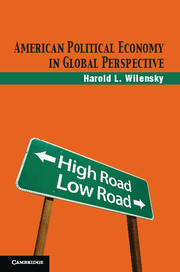Book contents
- Frontmatter
- Contents
- Figures
- Tables
- Preface and Introduction
- Acknowledgments
- Part I Globalization, Public Policy, and the Well-Being of People
- 1 The Welfare State as the Center of Public Finance and Political Conflict
- 2 Energy Policy and Performance
- 3 What Trade-Offs Are Good and Bad for the Economy?
- 4 Retrenchment of the Welfare State?
- 5 Pensions Converge, U.S. Health Care Remains Unique
- 6 The Impact of “Globalization”
- Part II Moving the United States Off the Low Road
- Appendix
- Notes
- Bibliography
- Index
1 - The Welfare State as the Center of Public Finance and Political Conflict
Published online by Cambridge University Press: 05 June 2012
- Frontmatter
- Contents
- Figures
- Tables
- Preface and Introduction
- Acknowledgments
- Part I Globalization, Public Policy, and the Well-Being of People
- 1 The Welfare State as the Center of Public Finance and Political Conflict
- 2 Energy Policy and Performance
- 3 What Trade-Offs Are Good and Bad for the Economy?
- 4 Retrenchment of the Welfare State?
- 5 Pensions Converge, U.S. Health Care Remains Unique
- 6 The Impact of “Globalization”
- Part II Moving the United States Off the Low Road
- Appendix
- Notes
- Bibliography
- Index
Summary
The essence of the welfare state is government-protected minimum standards of income, nutrition, health and safety, education, and housing assured to every citizen as a social right, not as charity (Wilensky, 1965: xii). In the abstract this is an ideal embraced by both political leaders and the mass of people in every affluent country, but in practice it becomes expensive enough and evokes enough ambivalence to become the center of political combat about taxes, spending, and the proper role of government in the economy. In public expenditures, the welfare state is about half to three-quarters of what modern governments do. The core programs of the welfare state, often subsumed under the general heading of “social security,” have taken the form of social insurance against the basic risks of modern life: job injury, sickness, unemployment, disability, old age, and income lost because of illness, shifts in family composition, or other random shocks (wars, depression, recessions). Because the welfare state is about shared risks crosscutting generations, localities, classes, ethnic and racial groups, and educational levels, it is a major source of social integration in modern society. Because it lends a measure of stability to household income, it has also been an important stabilizer of the economy in the downswings of the business cycle especially since World War II.
Because the welfare state is the center of efforts to rein in public spending and because many economists and public officials assume that social spending is the root of our economic troubles, I shall first concentrate on its economic effects, with special attention to why reform efforts are most successful where social partners negotiate realistic compromises. Later I broaden the analysis to include noneconomic effects.
- Type
- Chapter
- Information
- American Political Economy in Global Perspective , pp. 3 - 14Publisher: Cambridge University PressPrint publication year: 2012



